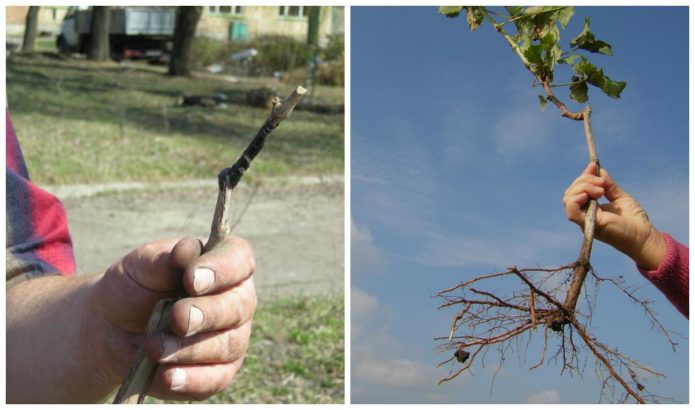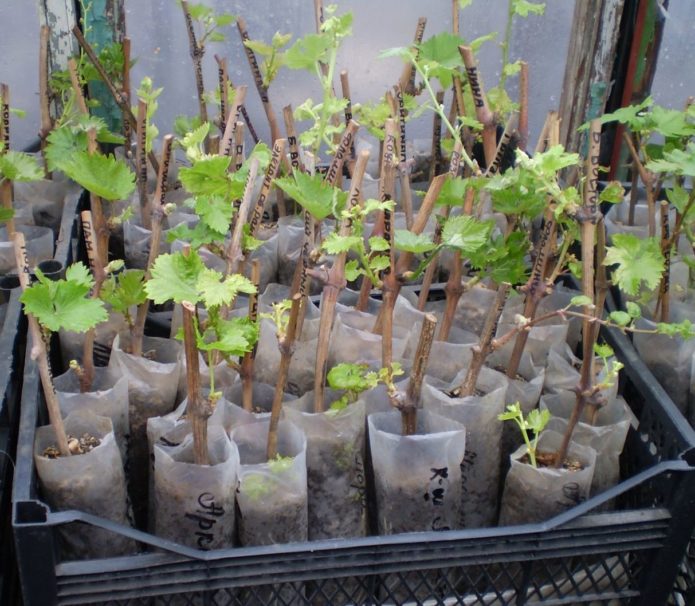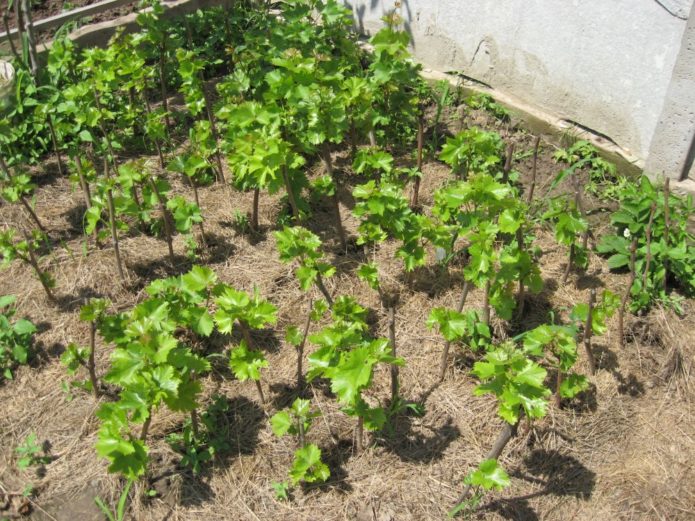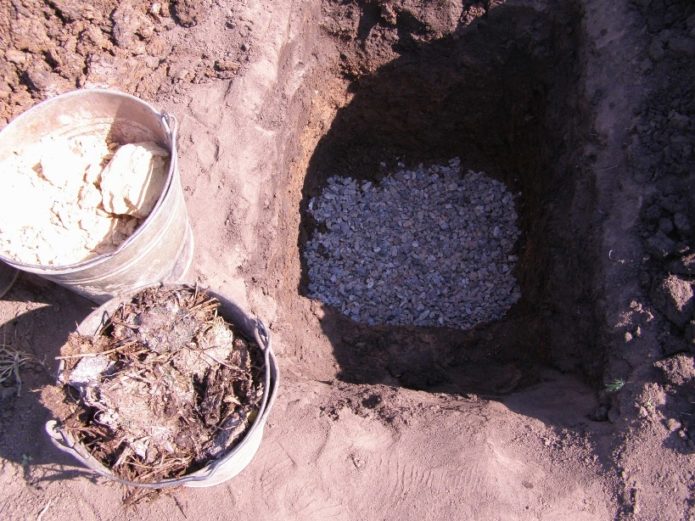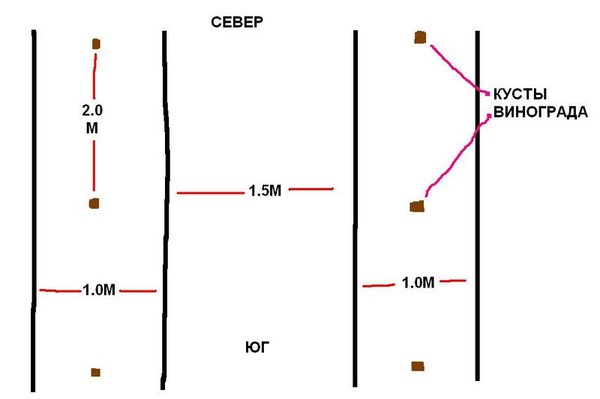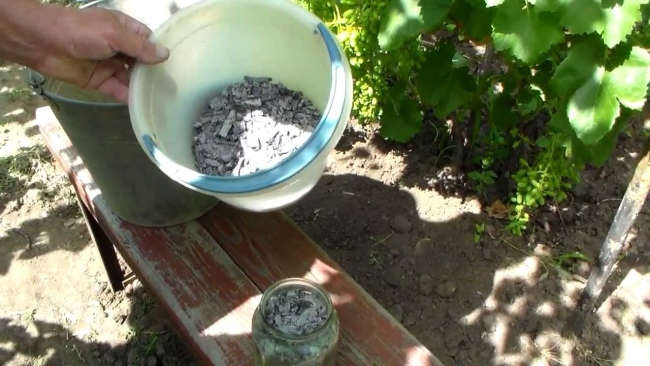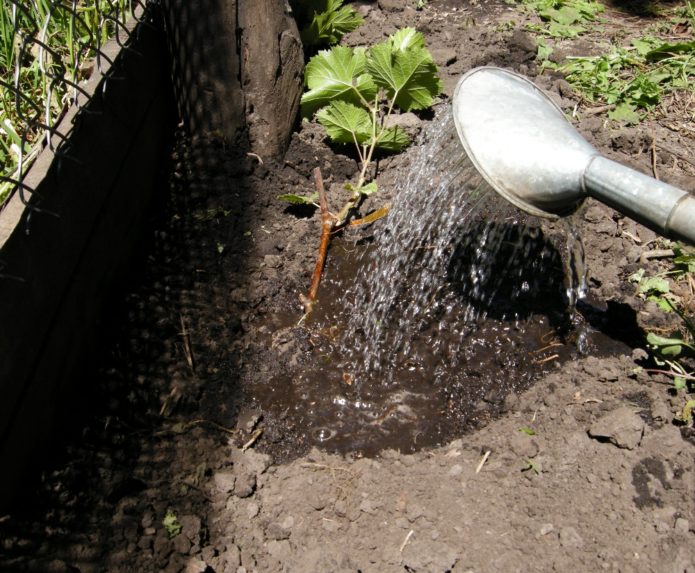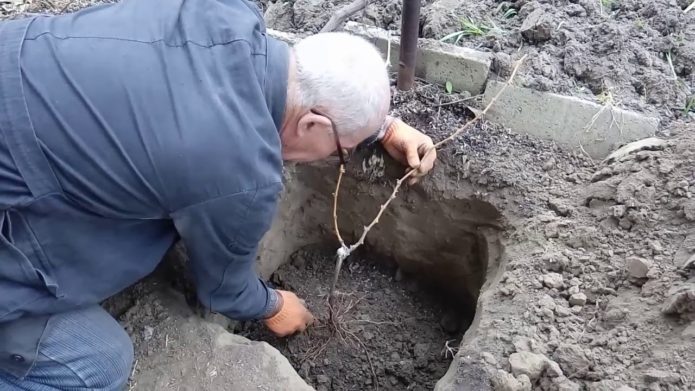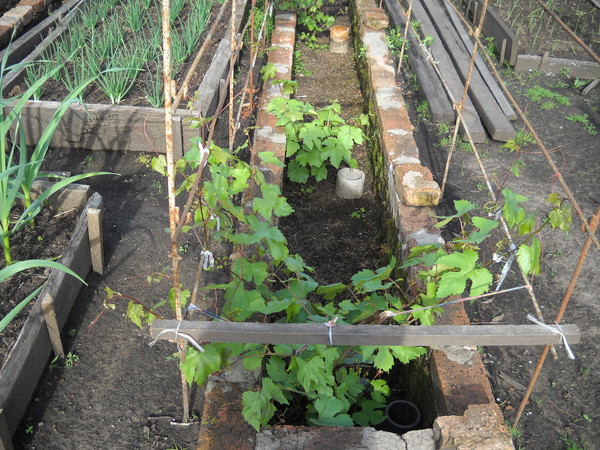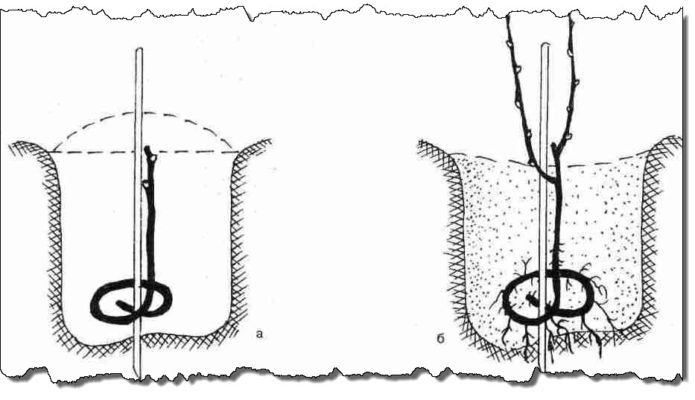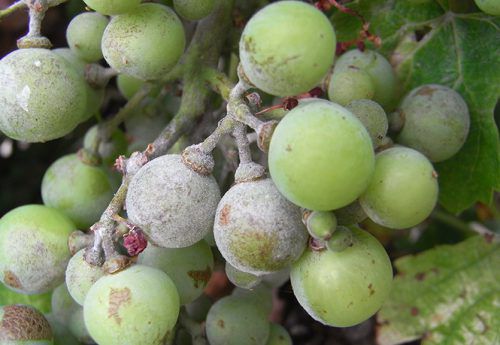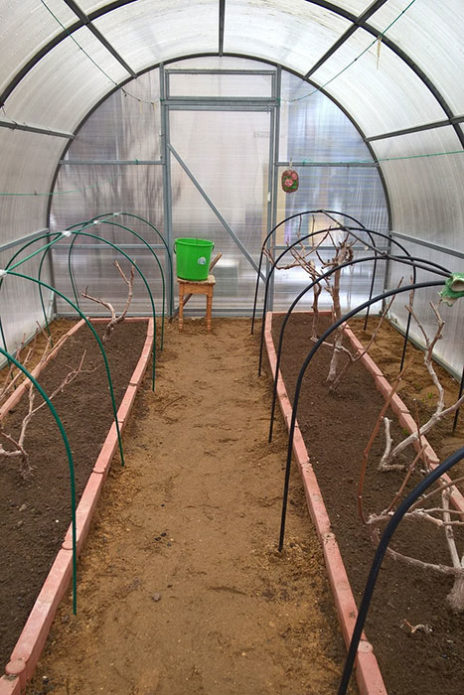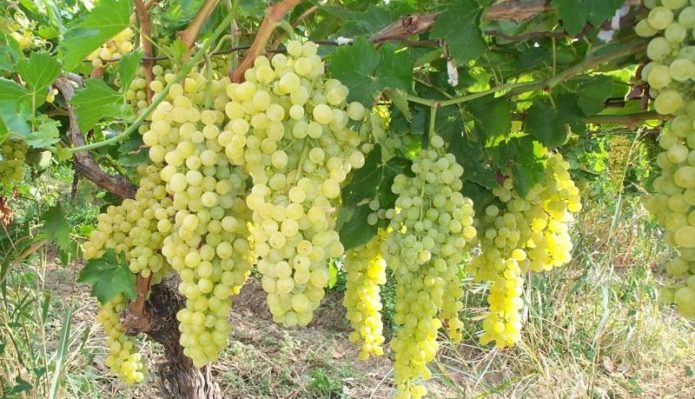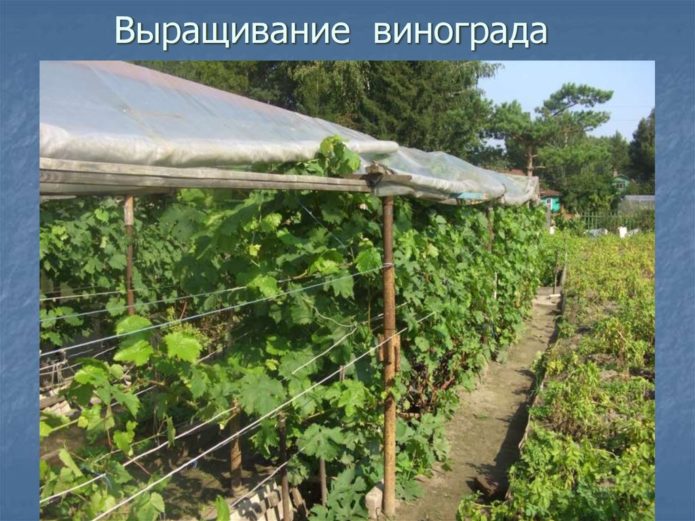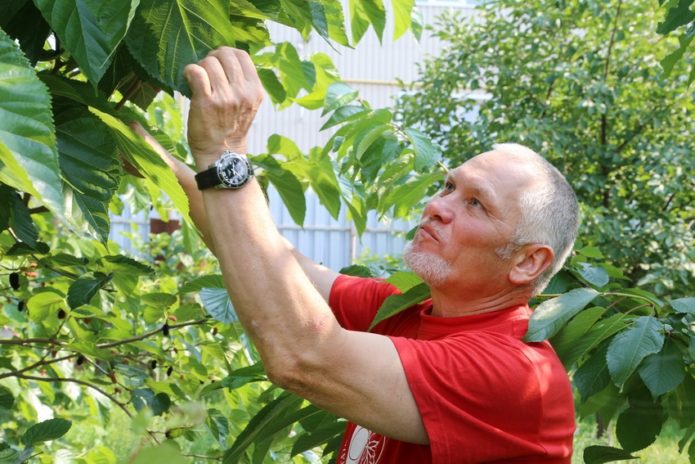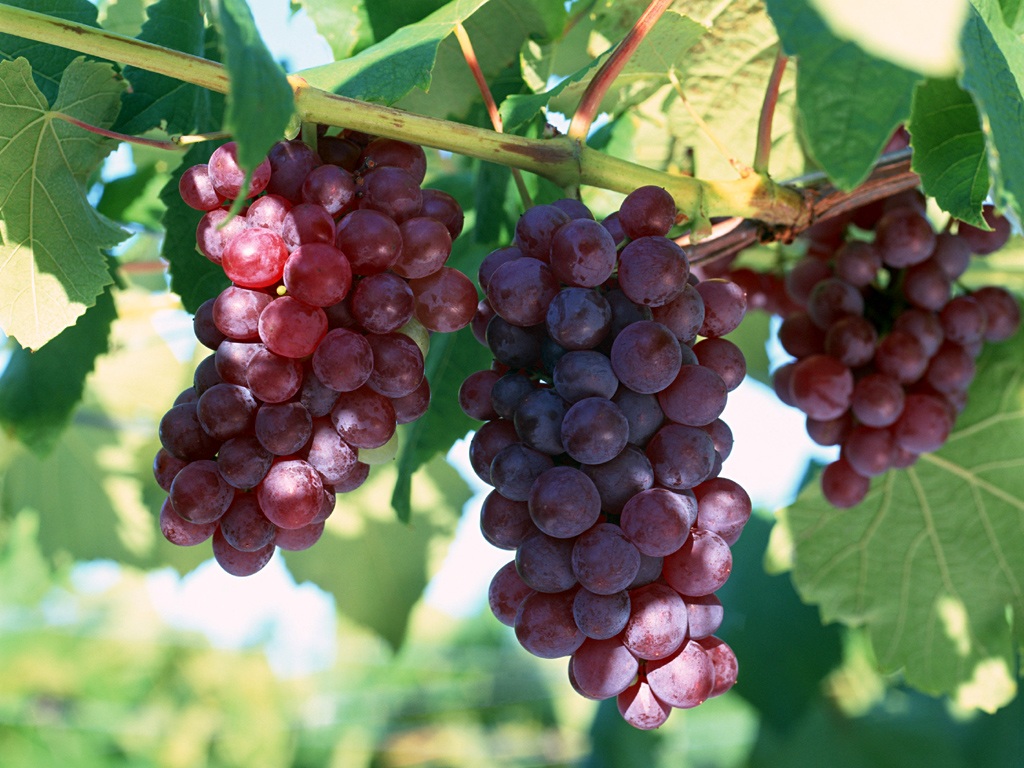Growing grapes in northern latitudes is quite a popular activity today. Many gardeners boldly take on this and get a harvest. Others find it difficult and risky to grow grapes in their own garden. So I want to say - there is nothing complicated here. Planting technology is available to everyone, the costs are no more than when planting any other garden plant. Warmth, light and caring hands - all that grapes need in your garden!
Content
Planting grape seedlings
Grape seedlings can be of two types: grafted or with their own roots.
Grafted seedlings:
- expensive;
- usually more valuable in terms of varietal characteristics: tastier and more productive;
- do not get sick with phylloxera;
- may freeze in winter or break off at the rootstock, then "uncultured" growth will grow from the root.
When buying a grafted seedling, you need to carefully examine it: there should be a noticeable tubercle at the junction of the scion and rootstock, if it is not there, the seedling is rooted, you should not overpay for it.
Own-rooted seedlings:
- do not be afraid of freezing, if the roots are not damaged, the plant will recover;
- may die from phylloxera;
- cheaper than vaccinated.
When buying, watch: roots, trunk, buds.
The more roots the better. Make sure the roots are alive: if you pinch off a piece of root with a knife, the cut of a quality plant will be white and damp. If the cut is dark or dry, then the seedling is dead.
The barrel must be free of damage and irregularities. If you scratch the bark a little, then there should be a green, moist layer of cambium under it. If not green and damp, alas, the seedling is no longer a tenant.
If you do not press hard on the kidneys, then they should sit tightly on the trunk, not fall off or peel off.
Do not take a seedling with leaves in the fall: it will not winter well.
Storage of seedlings before planting
Storage methods will depend on the time of purchase.
Autumn storage
In the fall, it is necessary to provide seedlings with a temperature of 3-4 degrees above zero (extreme temperatures for storage not lower than 0 and not higher than +10 degrees) and moderate humidity. You can store:
- to the basement;
- digging into the ground;
- on the bottom shelf of the refrigerator.
In the basement, you can stick it into a container with wet sand. It is important to check during the winter so that the sand does not dry out.
You can determine the sufficient moisture content of the sand by squeezing it into a handful. Sand will be suitable that does not crumble, but water does not drip from it.
You can save seedlings by simply digging into the ground on the site. We dig a trench about half a meter long and wide. The north side slopes vertically, the south side slopes 45 degrees. Before planting, soak the seedlings in water for one or two days, remove the damaged parts, lay them with roots to the north, trunks on the southern slope. Cover with earth to a mound.
It is better to mix the soil for backfill with sand or peat to make it easier to remove the seedlings in spring.
In April, seedlings can be dug up. Don't be alarmed if mold appears on them. Wash the seedlings in a weak solution of potassium permanganate (slightly pink).
If there are few seedlings, then you can store them in the refrigerator. Wrap the seedling in a damp cloth or paper, put in a plastic bag and store on the bottom shelf or in the vegetable section (the temperature should be + 4-6 degrees).
Preserving seedlings in spring
If you bought seedlings with an open root system, then store them before planting by wrapping the roots with a damp cloth or paper in a cool place.
Preparing seedlings for planting
If the seedlings are in your container, then they do not require special preparation for planting. Unless you need to accustom them to the open air gradually. It is best to place the containers on the windowsill before bud break. Then transfer to the greenhouse, where to wait for the appearance of young shoots. And only when the outside temperature is above zero and at night, you can harden young plants.
Quenching sequence:
- carry out several days in the daytime in the shade;
- for two - three days, leave to spend the night on the street;
- for a day - two move to the sun;
- plant in open ground.
If you have seedlings with an open root system, then before planting you need to saturate them well with moisture by placing them in water with a solution of a growth stimulator (for example, with Kornevin) or simply adding honey to the water.
Choosing a place for grapes
The main thing when choosing a place for grapes is a lot of light and warmth. The place should be closed from the north wind. That is, we need an area lit by the sun all day and with a fence from the north from the wind. These can be curtain plants (growing no closer than 2 meters to the grapes), a fence, a building wall.
It is logical to plant grapes near some southern wall of the building, but this is not suitable for all areas. So, in the northern regions of Russia, it is better to plant grapes near the southwestern or western walls. The land poor in humus warms up slowly, and on the southern side, the upper part of the land can warm up quickly, the vine will begin to flow. If there is a frost at night, the water in the plant's cells will freeze and tear them apart. Therefore, the west and southwest are better than the south in our area. If you plan to grow grapes under cover, then the southeast and southwest will do. When planting in a greenhouse, you need to arrange the planting from north to south.
Also note that the closer to the foundation, the deeper the soil freezes. Therefore, it is not worth planting closer than 75 cm from the wall of the house. And it is important that no water drips from the roof onto the grapes.
The grape roots are deep, so it cannot be planted in places where the water table is higher than 1.5 m.
Preparing a pit for planting grapes
If your site does not consist of humus-rich black soil and is not flooded with water for a long time, then the landing pit is what you need.It will allow the grapes to root safely, drain off excess water and provide food for several years. It is better to prepare the pit in the fall so that the fertilizers dissolve and the soil settles. If you plant a seedling in non-settled soil, then settling, it can break the young roots.
There are different opinions regarding the size of the landing pit. Some believe that it is necessary to dig a hole at least 100x100x100 cm, for others, 30x30 is enough at a depth equal to the growth of the seedling. Honestly, I don't know which opinion is correct. Recommendations come from reputable authors, it is interesting that the more modern the publication, the deeper the landing pit.
I myself, guided by the idea of the "golden mean" and a reasonably lazy attitude, prepare pits no more than 50 cm in width, depth and width. At the bottom I pour 10 centimeters of broken brick, expanded clay or gravel for drainage. Further, a nutrient layer from a mixture of earth from a pit, humus and sand in equal parts. You can also add one part of crushed stone to this mixture. The last layer is clean earth or humus.
If, like me, your soil is acidic, then you must definitely reduce its acidity by adding dolomite flour or ash:
- in slightly acidic soil, 1 cup of dolomite flour or 1.5 cups of ash per pit
- with acidic - 2 glasses of dolomite or 3 glasses of ash.
And you can also deoxidize the soil by introducing chalk, gypsum or ground eggshell into it, you only need to take one and a half times more of them. Grapes need soil with neutral acidity.
If you use chemical fertilizers in your home, then add 50 g of superphosphate and nitrophoska to the soil mixture. Do not get carried away with increasing the dose of fertilizers, otherwise you can burn the young roots.
You need to fill the pit gradually, spilling the mixture with water several times and slightly compacting. If you are preparing a pit in the spring, then spill it with hot water (at least a bucket on the pit). The pit should not be completely filled up; it should be 20–25 cm below ground level.
From one source to another, the postulate wanders that grapes are not picky about soils, grows well on poor rocky soils. And of course it is. But the quality of the berries still depends on the soil. On light, nutritious soils, the berries are sweeter and larger. So it is worth taking care of the composition of the soil in the planting pit.
Watch a video of an experienced wine grower from Belarus Alexander Mchedlidze on the preparation of a planting pit for grapes and equipment in it for irrigation and feeding
Planting depth of grapes
The depth of planting of the seedling depends on the type of soil. It is believed that the ratio of soil type and planting depth should be:
- black soil or clay - 30 cm;
- sandy soil - 50 cm;
- loam and sandy loam 40 cm.
The roots of grapes, depending on the variety, can withstand temperatures from minus 6 to minus 10 degrees. Michurin varieties and varieties based on Amur grapes can withstand temperatures of minus 12 degrees. The deeper the planting, the better the root system is protected from freezing temperatures.
So, we put the seedling in our pit (it is below ground level by 20-25 cm, you remember), deepening its root heel (the lowest point where the roots grow) by 5-10 cm (this is a recommendation for black soil or clay, to bury it in the sand 25 cm, in loam 15 cm). Until autumn, the seedling grows in a well-warmed hole, which is convenient to water.In the fall, the pit must be filled up to the top with fertile soil, before being covered for the winter.
Grape planting scheme
To ensure that the grapes receive sufficient light, arrange the rows from north to south.
The distance between seedlings in a row depends on the cultivation form. A vine is a "sleeve", it can be short (1.5m) and long (from 2.5m), it can be the only one on the plant ("one sleeve"), or there can be several of them. Depending on this, the distance between plants should be:
- bush "with long sleeves" 3 m;
- bush "with short sleeves" 2 m;
- bush "with one sleeve" 1.5 m.
In the aisles, you can grow greens, strawberries and even vegetables. I plant dill and onions there, in addition to gastronomic benefits, they also protect grapes from diseases.
Fertilizers when planting
Potassium, calcium and phosphorus are very important for the nutrition of grapes. Potassium helps the plant's immunity and growth, its resistance to cold. Calcium is needed to increase the yield and sugar content of berries, for the ripening of the vine. Phosphorus is needed by fruit buds, it also increases sugar content and accelerates the ripening of berries.
The best natural fertilizer for grapes is manure. It will provide the plant not only with phosphorus, nitrogen and potassium, but also with various trace elements. Manure is introduced into the vineyard once every three years, at the rate of 5–7 kg per 1 m of soil. Better to bring it in the fall for digging.
Those who are not afraid of chemistry, when planting, add 1-2 tablespoons of complete mineral fertilizer AVA or 50 g of superphosphate and nitrophoska each to the topsoil, mixing them with the soil.
Nitrogen fertilizers inhibit root development, so it is better not to use them when planting.
Watering after planting
Before planting, a seedling with a closed root system is well spilled before being removed from the container. It has already been said about the saturation of moisture in seedlings with an open root system. Let's consider this as the first watering.
The second watering should be done with warm water a week after planting. And a week later - the third. Then, until the end of the season, water the seedling about once a week. After watering, be sure to loosen the ground around the plant, if it is not covered with non-woven material.
In the matter of watering, of course, you need to focus on the features of your area. If your summer is very dry, then you need to water the seedling at least every day with half a bucket of water. If the summer is wet, then it is enough to pour the same half a bucket under the grapes once a week. But in any case, the water must certainly be warm! With prolonged cold and rainy weather, watering is stopped. From the second half of August, you need to stop watering the grapes, pinch the top of the plant so that the shoots ripen well and are ready for wintering.
By the way, grapes have periods when they do not need to be watered at all: this is before and during flowering and before harvesting.If you water the plant during these periods, the color will fly around, and the harvest will slow down ripening.
Ways of planting grape seedlings
The methods of planting grapes differ in the method of preparing the site for the seedling and the type of planting material itself. It is best to plant grapes in the spring so that the plant can grow stronger and prepare for winter.
The classic way
Typically, container-grown plants are planted like this:
- it is good to shed seedlings before planting, so that it is more convenient to take them out with a whole lump of earth;
- remove or cut the container;
- put a seedling at the bottom of the planting pit, stick a stick on the north side, to which we will tie the seedling;
- fill the hole to the height of an earthen coma, compact it slightly, pour with warm water;
- finally fill up the hole with earth to the first leaf on the shoot.
Video about planting grapes in the ground
Hill landing
They act a little differently with seedlings harvested in the fall (those that were stored in the cellar, refrigerator or dug into the ground):
- pour a mound of good earth on the bottom of the pit;
- put a seedling on it, spread the roots so that they look down, squeeze them into a mound;
- from the north side, also drive in a tying stick;
- cover with earth to the first bud, pour with warm water;
- after watering, the earth will settle, and again it is necessary to fill it up to the first bud;
- pull the seedling up a little so that the roots stretch down better.
With this method of planting, the hole will not be half filled, and the seedling will be 25-30 cm below the ground surface. As the shoot grows, the hole is covered with soil, thus increasing the surface overgrown with roots that feed the plant.
To protect the seedling from recurrent frost, it is worth covering it with a plastic bottle with a cut-off bottom. But by July, the shelter must be removed so that the seedling has time to harden.
Planting grapes in trenches
In the northern regions, where there is a threat of deep freezing of the soil, it is better to plant grapes in trenches.
Landing technology:
- dig a trench 20-30 cm deep, 100 cm wide, and a length corresponding to the number of seedlings, between which there will be a distance of 1.5 m;
- overlay the walls of the trench from all sides with boards, or brick, slate, etc.;
- install a trellis near the trench;
- dig planting holes in the trench in the usual way, so that the roots of the seedlings are located at a depth of 60–70 cm;
- grow vines with a "long sleeve", leading out of the trench to the trellis;
- in the fall, remove the shoots from the trellis, lay them in a trench;
- cover in layers: special shields, then straw or sawdust (20 cm), cover it with a film from moisture, 10 cm of earth on top, shovel up snow in winter (at least 20 cm).
Under such a "fur coat" no frosts are terrible for grapes.
The use of trellis when growing grapes
The grape is a vine, therefore, it needs support. In the wild, he lives, twisting trees and clinging to rocks. Therefore, placing it on the trellis is natural and convenient.
Video recommendations for trellises
Tapestries are different in shape and number of planes. But they all consist of supports and a wire stretched between them. The best supports are made of steel or asbestos-cement pipes (diameter 50–100 mm). Wooden supports will be cheaper, while they can last long enough. Oak poles, for example, will last about 20 years. It is better to take the wire with a plastic coating, with a diameter of 2–5 mm.
The simplest trellis can be made by tying a wire to the pipes, forming two parallel rows at a height of 40 cm from the ground.
For the first two years, the grape shoot is simply tied to the post. In the third year, the vine is first laid on a horizontal trellis, twisting both wires in turn. In the fourth year, you can add another trellis at a distance of 40 cm from the first.
So that there is no shadow in the aisles, you need to use a single-plane trellis, exposed in the direction from north to south.This is especially important for the northern regions.
Landing on the ridges
Growing grapes in the ridges is a great way for colder climates. This method allows
- protect the vine from spring flooding;
- quickly warm up the soil in the spring;
- enrich the soil with oxygen;
- spend less labor on weed control.
Landing technology:
- dig a trench: 100 cm in length and width, 30 cm deep;
- prepare the soil mixture in the usual way (in equal parts of humus, earth, sand, you can add rubble, fertilize with ash or complex fertilizer);
- fill the trench with soil so that the ridge is 30–35 cm above the ground, making gentle slopes;
- mulch the ridge or cover it with spunbond;
- plant the plants so that their roots are at a depth of 40 cm from the surface of the ridge;
For better illumination, you need to orient the ridge from north to south. To strengthen the walls of the ridge and warm it, you can bury dark plastic bottles with a cut bottom around its perimeter.
Planting in a greenhouse
In our cold region, grapes feel best in a greenhouse, because it is warm, light and dry. It is clear that it ripens in a greenhouse 14 days faster than outdoors. It is also more convenient to protect grapes from pests in the greenhouse. And it’s just more pleasant to work in it, caring for the grapes.
Video about growing grapes in a greenhouse
The technology of planting seedlings in a greenhouse can be any - classic in a hole or in a trench. It all depends on your climate and the material of the greenhouse. The distance between seedlings should be at least 1.5 m.
It is important when planting in a greenhouse to use varieties with bisexual flowers that do not require additional pollinators.
For the winter, the plants are covered with several layers of dense lutrasil stretched over arcs. During thaws, you need to open the windows in the greenhouse.
Moldovan planting
There is an ancient Moldovan way of planting grapes. For him, in the spring, a vine is taken (ripe, but flexible, not too thick) with a length of 60 to 200 cm. It is twisted several times in a ring, fixed with a rope. Then the ring is placed in a pit to a depth of 15–20 cm (in some sources 40–50 cm) so that one or two buds are visible on the surface. A hill of earth is poured over the end of the vines to retain moisture. The ground around is covered with mulch.
In the fall, a strong plant will develop from such a seedling, which will begin to bear fruit the next year. Because roots grow along the entire length of the vine, which intensively nourish the buds.
The method is good if you have an excess of planting material and a warm enough climate to plant cuttings without first germination. It is also important to keep in mind that the method is only suitable for self-rooted plants!
Planting by thickening
There is a method of planting grapes specific for hot climates, when up to 7 grape seedlings are placed on one square meter. This method is called thickening. It is quite good for dry places, because with dense planting, the roots do not grow horizontally, but rush deeper, vertically, thus providing the plant with moisture better.
In this case, the grapes are grown in bush form without a garter. The annual growth just lies on the ground. Vines are cut short on a low stem (30–40 cm). This is a very economical way of growing, does not require the installation of supports and special labor. The downside is that dense thickets are an excellent environment for fungal diseases and the yield with this method is low.
Diseases of seedlings after planting and how to deal with them
Grape seedlings sometimes get sick. Diseases can be spread by birds, insects, wind. The most dangerous diseases:
- anthracnose;
- mildew - downy mildew;
- oidium - powdery mildew;
- gray rot;
- black spot.
As always, it is better to prevent infection than to treat the plant later. In the fall, cut off shoots and fallen leaves must be carefully collected and burned so as not to give a chance for fungal spores to multiply. The grape crown and the ground under it must be sprayed with copper-containing chemicals (copper sulfate, Bordeaux liquid, Cuproxat, Horus, Copper oxychloride, etc.).
In the spring, before the leaves bloom, you need to treat the grapes with a 3% solution of Bordeaux liquid. For 5 liters of warm water, take 300 g of copper sulfate, mix. In another bucket for 5 liters of water, take 300 g of slaked lime. Pour the copper solution into the lime mortar. Stir, strain, spray. If necessary, repeat the treatment after 2-3 leaves bloom, before and after flowering.
Well, of course, you need to choose varieties that are resistant to diseases.
In addition to diseases, insects harm grapes: spider mites, grape itch and leafworms (two-year-old, grape, bunchy). It is impossible to protect yourself from them without chemicals, therefore they destroy pests with the help of chemical acaricides - Talstar, Neoron, Sunmayt, Aktelik, Omayt, Bi-58, Fury. For processing times and dosages, see the product packaging.
Planting grape seedlings in different regions
The conditions for feeding grapes, the duration of the period of its growth and dormancy depend on the climate. The most favorable climate for grapes is long, dry, hot summers and mild winters. Consider the features of planting grapes in different areas.
Landing in Ukraine
The climate of Ukraine is generally favorable for growing grapes, with the exception of its northern regions. There is probably not a single garden here where grapes grow. Ukraine is famous for its black soil. Planting grapes in a soil rich in organic matter and minerals has its own characteristics:
- a planting pit is not needed, it is enough to punch a hole with a crowbar and you can plant;
- it is not necessary to apply nitrogen fertilizers on humus-rich soils;
- in the steppe zone of Ukraine (there is little snow in winter, but there are frosts), you still need to plant in planting holes, deepening the root 40-50 cm from the soil surface so that the root system does not freeze;
- It is very common in Ukraine to infest vineyards with phylloxera, therefore, for planting, grafted seedlings should be preferred, on rootstocks resistant to this disease;
- Ukrainian winegrowers prefer the autumn planting of grapes.
For the winter, grapes in most of Ukraine still require shelter or hilling, since frosts up to minus thirty degrees are possible.
Landing in central Russia and the Moscow region
The climate of central Russia is moderately continental: frosty winters, warm, humid summers. And although our climate cannot be considered favorable for grapes, its cultivation in central Russia is very common. Of course, here you need to take into account the peculiarities of local agricultural technology.
In particular, with regard to landing, one must keep in mind:
- the soil here warms up shallowly - up to 40 centimeters, so the plant does not need to be particularly deep when planting, the planting time is from late May to June, wait for the weather when the temperature at night reaches 15 degrees Celsius, then you can plant;
- varieties you need to choose frost-resistant with early and very early ripening periods (it is better if the buds to berries are less than 110 days), they need to be bought from local producers;
- plant in planting pits or trenches, however, in flooded areas with high groundwater, choose a method of planting in ridges;
- in order not to depend on the vagaries of the weather, it is most convenient to grow grapes in a greenhouse in our strip.
Video about planting grapes in the Moscow region
Landing in Crimea
Viticulture in Crimea has been known since ancient times. The climate and soils of Crimea differ in different regions, the most favorable for grapes is the southern coast of Crimea. Growing grapes here does not require shelter.
Features of planting grapes in Crimea:
- the best time for planting is considered the end of October - mid-November, however, if the weather is dry, then you can plant even in December;
- the minimum planting depth of the seedling is 30 cm;
- landing pattern is preferable 3 mx 1.5 m;
- in Crimea, they prefer to plant grapes not with saplings, but with shanks, during the autumn pruning of bushes, when there is an abundance of this planting material.
Landing in Siberia
Siberia is characterized by a continental climate with an average annual positive temperature of 2100-2200 degrees. For outdoor cultivation, you need to choose early and very early varieties.
- You can start planting grapes in Siberia at the end of May, when the temperature is at least +15 degrees;
- diseases and pests of grapes do not like the Siberian climate, therefore, chemical treatment is required minimal;
- The worst thing that can happen to grapes in Siberia is when frosts strike at the beginning of summer, from which nothing can save young shoots, there will be no harvest, but the bushes themselves can be saved by cutting out all the frozen parts and providing the bush with enhanced nutrition;
- therefore it is best to grow grapes in a greenhouse or covered trench.
Landing in Moldova
Moldova with its temperate continental climate, mild, short winters and hot, long, dry summers is an excellent place to grow grapes.
Grapes have been grown here since time immemorial. Chernozem soils do not require the laying of labor-intensive planting holes. The grapes are grown uncovered.
Landing in the Krasnodar Territory
Krasnodar Territory is a favorable place for viticulture. A high sum of active temperatures and a large number of frost-free days are what the vine needs. The amount of sunlight and low air humidity play a decisive role for the sugar content of grapes. Therefore, in good years in the Krasnodar Territory, grapes are distinguished by a high sugar content.
Krasnodar Territory is an area of non-sheltering grape culture, however, local gardeners on their forums still advise sheltering it for the winter, just in case. The soils here are mostly black earth, slowly freezing, because they are rich in humus, provided with phosphorus and potassium. Therefore, there is no urgent need for planting holes. Many experienced growers do not practice them here. It is advised to plant plants at a distance of 3 m from each other and 3 m between rows. The best time for planting is autumn.
In the Kuban, great attention should be paid to the processing of grapes from pests and diseases, which feel great in a humid and warm environment.
Landing in the Belgorod region
Belgorod Region is the southern part of the Central Black Earth Region of Russia. It has fertile soil and a suitable climate for viticulture. For open ground, it is better to choose early varieties. Shelter is a must for the winter.
Belgorodets Sergey Shagiv created a whole laboratory of viticulture and winemaking in his area.On his farm, he grows European table varieties and believes that the climate of the Belgorod region suits grapes even better than the southern one.
Someone might think that the technology of planting grapes is too complex, and the work ahead is too large-scale. It seemed to me, at least, for a long time. But once taking on this business, armed with books, the Internet, advice from neighbors, I realized that there is nothing terrible and complicated. It's just that the road you walk on for the first time always seems to be longer. It is very interesting and easy to grow grapes, you just have to plant your first vine once. I wish everyone to take their successful first step!
